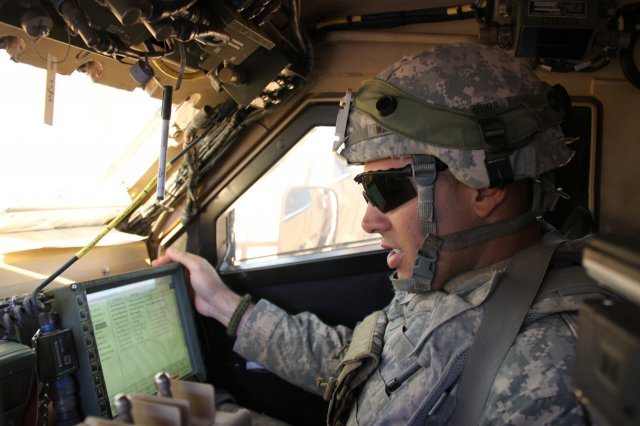On the dynamic and complex battlefield, the Common Operating Environment will streamline communications between Soldiers in vehicles and higher headquarters, creating seamless interoperability between the computers, sensors and applications they use.
Developed by the Office of the Assistant Secretary of the Army for Acquisition, Logistics and Technology, known as ASA (ALT), in October 2010, the Common Operating Environment, or COE, is a set of computing technologies and standards. They are designed to enable secure and interoperable applications to be rapidly developed and executed across a variety of environments. The Mounted Computing Environment, or CE, is one of six computing environments that support this goal.
“Through this Army-wide effort to collapse capabilities and integrate them into vehicles, Soldiers can communicate more seamlessly with upper echelons,” said Peter Dugan, a systems engineer with the Army’s Program Executive Office for Command, Control and Communications-Tactical, known as PEO C3T.
Dugan explained PEO C3T’s role in leading the Mounted CE Nov. 10, during a panel at MILCOM 2011, an annual international conference focused on military communications and networks held at the Baltimore Convention Center in Baltimore, Md.
The Mounted CE is a standard in which systems are set inside vehicles that have large amounts of processing power, but contain much less bandwidth than a tactical operations center. “Its existence,” Dugan said, “will be seamless to the user.”
“The end user should not be aware of the fact that there is a CE out there,” Dugan said. “The COE and the CE should allow developers to quickly build their applications onto this environment, and then they just need a good capability with a common map and common infrastructure,” he said.
Dugan outlined how the Mounted CE would bridge the computing divide. The application includes three classes of capabilities: the first involves transmitting small messages connected to a host; the second includes integrating more functionality and sharing data at the local level; and the third concerns adapting to the new environment.
Michael Anthony, chief of the Mission Command Division for the U.S. Army Communications-Electronics Research, Development, and Engineering Center, or CERDEC, Command and Control Directorate, known as C2D, said employing a common set of standards into a Common Operating Environment on the tactical network would enable users to “copy and paste” information across separate tactical applications.
“Just like we do when we take a bullet from a Microsoft Word document and paste it into a PowerPoint slide,” he said.
Monica Farah-Stapleton, systems of systems engineer for ASA (ALT), said COE standards (like the Mounted CE) help the PEO community indentify the many business and cultural processes that must occur to make an application technically feasible. These processes, she said, are “critical enablers.”
“We have to take advantage of whatever efficiencies are available to us,” she said. “So, we look at the Common Operating Environment as a forcing function for an element of change across the PEO community.”
The other five environments include: dismounted handhelds, sensors, real-time safety critical, Tactical Operations Centers and Command Posts, and the Data Center Cloud, a standard that uses enterprise services to pass data from a centralized hub.










